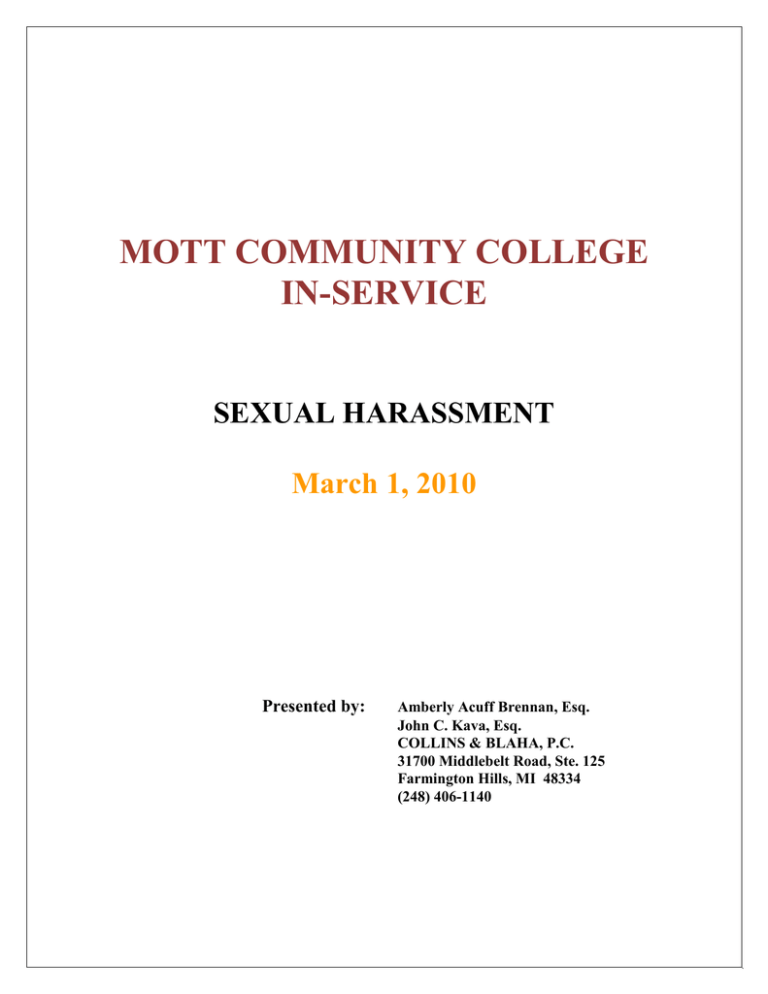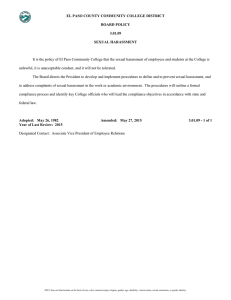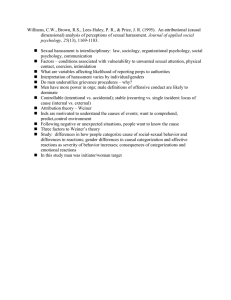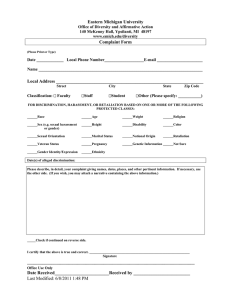
MOTT COMMUNITY COLLEGE
IN-SERVICE
SEXUAL HARASSMENT
March 1, 2010
Presented by:
Amberly Acuff Brennan, Esq.
John C. Kava, Esq.
COLLINS & BLAHA, P.C.
31700 Middlebelt Road, Ste. 125
Farmington Hills, MI 48334
(248) 406-1140
INDEX
Page
I.
INTRODUCTION.......................................................................................... 1
II.
TYPES OF SEXUAL HARASSMENT ....................................................... 1
III.
LAWS GOVERNING SEXUAL HARASSMENT ........................................3
IV.
STUDENT TO STUDENT SEXUAL HARASSMENT ............................... 5
V.
EMPLOYEE TO STUDENT HARASSMENT ............................................. 6
VI.
EMPLOYEE TO EMPLOYEE HARASSMENT.......................................... 8
VII.
SAME-SEX HARASSMENT AND SEX STEREOTYPING....................... 8
VIII.
INVESTIGATING SEXUAL HARASSMENT ALLEGATIONS ................ 8
IX.
MOTT COMMUNITY COLLEGE SEXUAL
HARASSMENT POLICY ........................................................................... 11
X.
PROCEDURE FOR REPORTING AND INVESTIGATING
SEXUAL HARASSMENT ...........................................................................14
XI.
DOS AND DON‟TS REGARDING SEXUAL HARASSMENT:
A CHECKLIST FOR SUPERVISORS .......................................................17
XII.
THE “NEW” SEXUAL HARASSMENT IS MORE SUBTLE,
FORBES.COM, AUGUST 11, 2009 ............................................................20
SEXUAL HARASSMENT AND POTENTIAL LIABILITY
I.
INTRODUCTION
Sexual harassment is one of the more serious and potentially costly concerns facing employers
today. Educational institutions have been held liable for sexual harassment by staff and students,
as well as for related or resulting inappropriate physical touching or contact. Further, employers
have been held liable for negligent hiring and for the retention of employees who have
documented histories of misconduct.
In general, sexual harassment in the education setting arises in one of three contexts: when an
employee harasses a co-worker; when an employee harasses a student; when a student harasses
another student. This outline will provide an introduction to the different types of sexual
harassment and the potential liability of educational institutions and employees when adults
and/or students are sexually harassed.
II.
TYPES OF SEXUAL HARASSMENT
A.
QUID PRO QUO: When submission to or rejection of unwelcome
sexual advances, requests for sexual favors, and other verbal or physical
conduct or communication of a sexual nature is used as a condition or
factor in decisions affecting an individual's employment, or is used as a
condition or basis for educational decisions.
*
In general, the following factors must be proved to prevail in a quid pro
quo sexual harassment action:
1.
The individual belongs to a protected group;
2.
The individual was subject to unwelcome sexual harassment in the
form of sexual advances, requests for sexual favors, or conduct or
communication of a sexual nature;
3.
The harassment complained of was based upon sex;
4.
The individual's reaction to harassment complained of affected
tangible aspects of the employee's compensation, terms, conditions
or privileges of employment, or the student's educational rights,
benefits, privileges or opportunities;
5.
Respondent superior.
1
B.
HOSTILE ENVIRONMENT: When conduct or communication has the
purpose or effect of substantially interfering with an individual's
employment or ability to learn, creating an intimidating, hostile or
offensive employment or learning environment. In evaluating the severity
of the conduct, the educational institution should consider "the
constellation of surrounding circumstances, expectations, and
relationships." Davis, infra at 651.
*
In general, the following factors must be proved to prevail in a hostile
work environment action:
1.
The individual belongs to a protected group;
2.
The individual was subjected to unwelcome sexual harassment in
the form of sexual advances, requests for sexual favors, or other
verbal or physical conduct of a sexual nature (including demeaning
or dehumanizing references to sex, gender or sexuality);
3.
The harassment complained of was based upon sex;
4.
The charged sexual harassment had the effect of unreasonably
interfering with the employee's work performance and creating an
intimidating, hostile, or offensive working environment; or had the
effect of unreasonably interfering with the student's educational
performance and creating an intimidating, hostile, or offensive
learning environment.
5.
Respondent superior.
*
More specifically, the following factors should be considered in
an educational institution setting:
The degree to which the conduct affected one or more
employees/students' ability to work/education (has it limited or
denied the student's ability to participate in or benefit from the
educational institution's program?)
The type, frequency, and duration of the conduct (is it sustained
and serious?)
The identity and relationship between the alleged harasser and the
subject or subjects of the harassment (is the harasser an authority
figure over the employee/student?)
2
III.
The number of individuals involved (can be committed by or on
individuals or groups.)
The age and sex of the alleged harasser and the subject or subjects
of the harassment.
The size of the educational institution, location of the incidents,
and context in which they occurred (the smaller the educational
institution, the fewer incidents it takes to make a large impact.)
Other incidents at the educational institution (a series of incidents
not involving the same people could, taken together, create or show
an indifference toward a hostile environment.)
Incidents of gender-based, but nonsexual harassment (these can be
sufficiently severe to create a hostile environment.)
LAWS GOVERNING SEXUAL HARASSMENT
A.
STATE LAW
Michigan‟s Elliott-Larsen Civil Rights Act, MCL 37.2101 et seq., prohibits educational institutions
from discriminating against individuals on the basis of sex, including sexual harassment. The Act
defines sexual harassment as "unwelcome sexual advances, requests for sexual favors, and other
verbal physical conduct or communication of a sexual nature" when:
(1) submission to the conduct is made a condition for obtaining employment,
accommodation, education or housing;
(2) submission or rejection of the conduct is a factor in decisions regarding the person‟s
employment, accommodation, education or housing; and
(3) the conduct "has the purpose or effect of substantially interfering with an individual's
employment, public accommodations or public services, education, or housing, or creating
an intimidating, hostile, or offensive employment, public accommodations, education, or
housing environment." MCL 37.2103(i)
Thus, educational institutions must be careful not to discriminate against employees or students on
the basis of sex, and to treat each allegation of sexual harassment promptly, effectively and in
accordance with required local policies and procedures.
B.
FEDERAL LAW
When students began bringing claims against educational institutions based upon student-tostudent sexual harassment, one basis of proposed liability was Section 1983, which provides:
3
Every person who, under color of any statute, ordinance, regulation, custom or
usage, of any state . . . subjects, or causes to be subjected, any citizen of the
United States . . . to the deprivation of any rights, privileges, or immunities
secured by the Constitution and laws, shall be liable to the party injured in an
action at law, suite in equity, or other proper proceeding for redress. 42 USCS
1983.
Fortunately, most courts have dismissed Section 1983 claims for peer sexual harassment.
However, Section 1983 may still be used where there is a question of misconduct by an educational
institution employee.
Likewise, Title VII of the Federal Civil Rights Act of 1964 prohibits an employer from
discriminating against an individual “with respect to his compensation, terms, conditions, or
privileges of employment” on the basis of sex. 42 U.S.C. § 2000e-2(a)(1).
In order to make a complaint under Title VII, a charge must be filed with the Equal Employment
Opportunity Commission (“EEOC”) within 180 days from the date of the alleged violation. The
employer is notified that the charge has been filed and the EEOC investigates. The EEOC resolves
discrimination charges by closing the case if the evidence does not establish that discrimination
occurred or by attempting conciliation to remedy the discrimination if the evidence establishes that
discrimination occurred. If the EEOC is unable to conciliate the case, the agency will decide
whether to bring suit in federal court; if the agency decides not to sue, it will close the case and
give the charging party notice of a „right to sue‟ within 90 days. Under Title VII, a charging party
may request a notice of „right to sue‟ from the EEOC 180 days after the charge was first filed and
may bring suit 90 days after receiving the notice. Remedies available for employment
discrimination may include back pay, hiring, promotion, reinstatement, front pay, reasonable
accommodation, or other actions that will make an individual „whole.‟
Title IX of the Education Amendments of 1972, 20 USCS 1682 et seq. is another federal statute
which prohibits discrimination on the basis of sex in educational programs or activities and
provides as follows:
No person in the United States shall, on the basis of sex, be excluded from
participation in, be denied the benefits of, or be subjected to discrimination under
any education program or activity receiving Federal financial assistance.
This 35 year old statute has, in recent years, found new life. Title IX is being used as a basis to
find educational institutions liable when a student sexually harasses another student or is sexually
harassed by a teacher or educational institution employee. For a public educational institution to
incur liability under Title IX, it must be (1) deliberately indifferent (2) to known acts of
discrimination (3) which occur under its control. Gebser v. Lago Vista Indep. Sch. Dist., 524 U.S.
274, 290-91, 118 S.Ct.1989, 141 L.Ed.2d 277 (1998). For a plaintiff to proceed on a claim against
an educational institution under Title IX, a plaintiff must establish a prima facie case showing that:
a) she was subjected to quid pro quo sexual harassment or a sexually hostile environment; b) she
4
provided actual notice of the situation to an “appropriate person,” who was, at a minimum, an
official of the educational entity with authority to take corrective action and to end discrimination;
and c) the institution‟s response to the harassment amounted to “deliberate indifference.”
Klemencic v. Ohio State University, 263 F.3d 504, 510 (6th (Ohio), 2001)
Courts have found that, although sexual harassment clearly constitutes discrimination under Title
IX, a public educational institution will only be liable for situations in which it exercises
substantial control over both the harasser and the context in which the known harassment occurs.
Specifically, the public educational institution‟s deliberate indifference must either directly cause
the abuse to occur or make students vulnerable to such abuse, and that abuse must take place in a
context subject to the institution‟s control. Increasingly, the focus of plaintiff‟s arguments is
becoming how the educational institution reacted to allegations of sexual harassment and what, if
anything, it did to stop the harassment.
On January 16, 2001, the Office of Civil Rights ("OCR") issued its "Revised Sexual Harassment
Guidance: Harassment of Students by School Employees, Other Students, or Third Parties," notice
of availability for comment at 13 Fed. Reg. Vol. 66 at 5512. A copy of this most recent guidance
is available at http://www.ed.gov/offices/OCR/archives/pdf/shguide.pdf for your review and
reference.
Note that the Office for Civil Rights for the US Department of Education interprets the Family
Educational Rights and Privacy Act (FERPA), 20 USC 1232g, as not in conflict with the Title IX
requirement that educational institutions notify the harassed student of the outcome of its
investigation.
IV.
STUDENT TO STUDENT SEXUAL HARASSMENT
The difficult task of defining sexual harassment becomes even more problematic when it is applied
to students. In general, sexual harassment is behavior of a sexual nature which is not welcome,
personally offensive, and interferes with the instructional atmosphere. Examples of sexual
harassment include the following: verbal harassment or abuse; unwanted pressure for sexual
activity; remarks about another person's clothing, body or sexual activities; unnecessary touching,
patting or pinching; constant brushing against another person's body; physical assault; sexually
suggestive actions, including gestures, whistling, insulting sounds or the use of suggestive or
graphic pictures or objects; spreading sexual rumors; spying on someone or watching someone
undress or shower.
Until recently, little consideration was given to the educational institution‟s liability for student-tostudent sexual harassment. However, the current trend is toward increased liability for a school's
failure to intervene and prevent known instances of sexual harassment by anyone in the school
setting. In Davis v Monroe County Board of Education, 526 US 629 (1999), the U.S. Supreme
Court decided that a school district could be sued and held liable in a private action for monetary
damages under Title IX of the Education Amendments of 1972, for failing to stop a student from
sexually harassing another student. The Court concluded that educational institutions would be
liable where it had actual knowledge of severe harassment and acted with deliberate indifference to
5
it. The ruling places an obligation on educational institutions to address student-on-student sexual
harassment.
It is yet unclear who must be told in order for the “actual knowledge” component of the Court‟s
decision to be met. Prior OCR decisions would have the “actual knowledge” triggered by a report
to any school employee. In Davis this component was satisfied because the harassment was
reported to a school principal and three teachers. However, the Court did not explicitly determine
how high up the chain of command the student must go before actual knowledge will be imputed
to the educational institution. Some advocates in favor of the Title IX liability in this setting will
argue that it is enough to tell the instructor, while more cautious proponents suggest that students
inform as high a level official as possible. Meanwhile, educational institutions should advise all
faculty to inform the appropriate school official of all incidents of alleged peer sexual harassment
so as not to subject the College to liability.
The Appropriate Response
The next element that plaintiffs are required to satisfy under the Court‟s ruling is that the
educational institution acted with “deliberate indifference” to the reported sexual harassment. But
like the previous component, this issue is unsettled. Certainly if an educational institution takes no
action in response to the complaint, there will be liability. However, there is a gray area where an
institution takes some level of action to end the harassment, which is argued to be inadequate. The
Davis Court states that to satisfy the deliberate indifference standard, the recipient of actual notice
of harassment “must merely respond to known peer harassment in a manner that is not clearly
unreasonable.” Davis, supra at 648-649. While there was no final recommendation given on what
level of action is required, educational institutions should act promptly and appropriately to claims
of student on student sexual harassment. However, the Office of Civil Rights Guidance requires
that school officials with actual notice of possible harassment of students, regardless of whether a
student makes a complaint or requests action, “should take immediate and appropriate steps to
investigate or otherwise determine what occurred and take prompt and effective steps reasonably
calculated to end any harassment, eliminate a hostile environment if one has been created, and
prevent harassment from occurring again.” See pg. 53, infra. Ultimately, lower courts and juries
will decide what level of response shows “deliberate indifference.”
Finally, plaintiffs must show that the alleged sexual harassment was so “severe, pervasive, and
objectively offensive” that students are precluded from benefiting from a public education. It is
not enough to show that a student has been “teased” or “called offensive names.” Such language
should serve to set the standard high enough so that immature behavior, unlike several verbal and
physical misconduct, is not the basis for Title IX liability.
V.
EMPLOYEE TO STUDENT HARASSMENT
There is a private right of action for monetary damages based on Title IX of the Education
Amendments of 1972, 20 USC 1681 et seq., against an educational institution that, after
receiving actual notice of sexual harassment, exhibits a "deliberate indifference" towards
the discrimination by failing to institute corrective measures. Gebser v Lago Vista Independent
6
School District, 524 US 274, 290-291; 118 S Ct 1989; 141 L Ed 2d 277 (1998). For a plaintiff to
proceed on a claim against an educational institution under Title IX, a plaintiff must establish a
prima facie case showing that: a) she was subjected to quid pro quo sexual harassment or a
sexually hostile environment; b) she provided actual notice of the situation to an “appropriate
person,” who was, at a minimum, an official of the educational entity with authority to take
corrective action and to end discrimination; and c) the institution‟s response to the harassment
amounted to “deliberate indifference.” Courts have noted that, in the college or university setting,
notice can be particularly difficult to define. Frederick v. Simpson College, 149 F.Supp.2d 826,
836 (S.D.Iowa, 2001). There are often more levels of administration at a college or university than
there are in an elementary or secondary school. The Court also noted that a different manner and
level of oversight is provided by a college or university administration, as the students are adults
and generally not children.
However, this does not preclude an educational institution from liability as seen in Mandsager v.
University of North Carolina at Greensboro, 269 F.Supp.2d 662, 675 (N.C., 2003), where a
doctoral candidate alleged that she was subjected to sexual comments, a sexual proposition, and
physical contact by a professor. When she initially complained about this conduct, the Dean
simply replied, “William will be William.” In addition, when she went to another Dean to
complain, he suggested to her that by making a complaint against a highly regarded faculty
member, she had chosen not to receive her PhD. The court determined that this Plaintiff stated a
claim under Title IX and a jury could determine that the institution‟s response was so inadequate
that it amounted to “deliberate indifference.”
In addition to liability for the College, the teacher or staff member found to have engaged in sexual
harassment could be liable to a student for their actions. In one case, the Court found there was
sufficient evidence for a jury to determine that a professor‟s comments to a student inside and
outside of class were pervasive, severe, based on the student‟s sex, and interfered with the
student‟s educational process. Hayut v. State University of New York, 352 F.3d 733, 738-739 (2nd
Cir, 2003). Initially, the comments in this case consisted of the professor calling the student by the
nickname “Monica,” in light of her supposed physical resemblance to Monica Lewinsky.
According to the testimony of some witnesses, the student initially laughed at the nickname, roller
her eyes, or simply shrugged her shoulders, giving no outward indication that the comments
troubled her. However, the professor‟s use of this nickname persisted even after the student
requested that he stop. The student maintained that the “Monica” comments occurred at least once
per class period throughout the rest of the semester and persisted in her absence. The student also
maintained that, on occasion, he addressed her as “Monica” outside of class when they happened to
pass each other. In addition to the “Monica” comments, the professor referred to some of former
President Bill Clinton‟s and Lewinsky‟s more notorious conduct, including “How was your
weekend with Bill?”, which the plaintiff claimed he asked virtually every Tuesday morning class
session, “Be quiet, Monica. I will give you a cigar later”, and “You are wearing the same color
lipstick that Monica wears.” The court concluded that the comments were sufficiently offensive
and severe and that a jury could conclude that the professor‟s comments constituted sexual
harassment thereby holding him liable for his harassing behavior. At the same time, the court
dismissed claims made by the student against the University because she could not show that
University officials were deliberately indifferent to the student‟s allegations.
7
VI.
EMPLOYEE TO EMPLOYEE HARASSMENT
To hold an employer liable for sexual harassment by one employee to another employee under the
Elliott-Larsen Civil Rights Act, the plaintiff must demonstrate that "either a recurring problem
existed or a repetition of an offending incident was likely and that the employer failed to rectify the
problem on adequate notice." Chambers v Trettco, Inc, 244 Mich App 614, 618 (2001). Notice
occurs based on an objective standard of whether in the "totality of the circumstances," a
"reasonable employer would have been aware of the substantial probability that sexual harassment
was occurring." Id. The Court in Chambers held that the plaintiff's general indication to her
regional director over the phone that "something was wrong" did not sufficiently alert him to the
alleged occurrences of sexual harassment. Id. at 614.
The Michigan Supreme Court has held that an agent who sexually harasses an employee in the
workplace can be held individually liable under the Act. Elezovic v Ford Motor Co, 472 Mich
408, 411 (2005).
VII.
SAME-SEX SEXUAL HARASSMENT AND SEX-STEREOTYPING
Same-sex sexual harassment can be actionable under Title VII of the Federal Civil Rights Act of
1964. Oncale v Sundowner Offshore Services, Inc, 523 US 75, 79-82 (1998).
Further, according to the Office of Civil Rights Guidance, harassing a student because he/she does
not conform with stereotyped notions of masculinity and femininity can violate Title IX "if it is
sufficiently serious to deny or limit a student's ability to participate in or benefit from the program."
If a student heckles another student regarding his sexual orientation but does not make comments
of a sexual nature, the actions would not necessarily violate Title IX (although the student could
certainly be disciplined under anti-bullying and other policies.) On the other hand, if a student
committed severe verbal, nonverbal or physical acts of aggression, intimidation or hostility based
on sex or sex-stereotyping, the conduct could form the basis for a Title IX claim.
Consequently, schools should respond to complaints from a student regarding alleged same-sex
sexual harassment just as it would if the victim were heterosexual.
VIII. INVESTIGATING SEXUAL HARASSMENT ALLEGATIONS
In addressing allegations of sexual harassment, it is important for employees to be aware of some
of the barriers that may prevent an employee/student from complaining about sexual harassment
from peers or from a faculty member:
A.
They may be confused or not understand what it means to be sexually harassed and
may not feel that the definition or concept of sexual harassment applies to them or
their situation;
8
B.
They may fear that the harasser will retaliate against them; that others will not
believe them, or may ridicule them or blame them for the harassment;
C.
They may want to avoid conflict or may not want to hurt anyone, especially a
respected authority figure;
D.
They may be confused about the educational institution's procedures for dealing
with allegations of sexual harassment and may feel that they are not prepared to take
actions required by the educational institution's procedures;
E.
They may feel that they are in some way responsible for provoking the harassment;
F.
They may like the extra attention he or she is receiving from the harasser.
Bearing these factors in mind, the following are some suggestions for addressing complaints of
sexual harassment in an effective, efficient manner which will lower the risk of the educational
institution and individual employee liability for sexual harassment under state and federal laws:
Develop a sexual harassment policy and distribute it to all staff and students;
Develop and distribute a sexual harassment complaint procedure that permits
alternative avenues for employees/students to express concerns. Remember, the
alleged harasser could be the employee's immediate supervisor or the student's
teacher or principal;
Develop an effective and sensitive procedure for conducting investigations of
alleged sexual harassment;
Provide training for all staff and students on the issue of sexual harassment;
Treat all allegations seriously;
Investigate all allegations immediately.
*
*
*
*
Be guided by due process and just cause.
Base confidentiality on a "need to know" basis.
Meet with an interview staff, students and parents who may have
information regarding the allegations.
Review all available records, such as student and personnel records,
previous complaints, calendars, etc.
If necessary, recommend appropriate remedial action, including discipline and
possible suspension or termination.
Follow-up and make sure the problem has been corrected.
9
Keep a detailed record of your investigation and any subsequent action taken.
Make sure you tell the complainant how the matter was resolved.
C:\CG\Presentations\MOTT Sexual Harassment In-Service 3.1.10.doc
10





